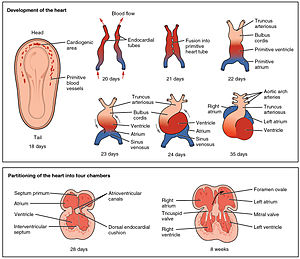| Heart development | |
|---|---|
 Development of the human heart during the first five weeks (top), and the formation of the heart chambers (bottom) at four and eight weeks. In this figure, the blue and red colors represent blood inflow and outflow (not venous and arterial blood). Initially, all venous blood flows from the tail/atria to the ventricles/head, a very different pattern from that of an adult.[1][2] | |
| Details | |
| Gives rise to | Heart |
| System | Fetal circulation, circulatory system |
| Anatomical terminology | |
Heart development, also known as cardiogenesis, refers to the prenatal development of the heart. This begins with the formation of two endocardial tubes which merge to form the tubular heart, also called the primitive heart tube. The heart is the first functional organ in vertebrate embryos.
The tubular heart quickly differentiates into the truncus arteriosus, bulbus cordis, primitive ventricle, primitive atrium, and the sinus venosus. The truncus arteriosus splits into the ascending aorta and the pulmonary trunk. The bulbus cordis forms part of the ventricles. The sinus venosus connects to the fetal circulation.
The heart tube elongates on the right side, looping and becoming the first visual sign of left-right asymmetry of the body. Septa form within the atria and ventricles to separate the left and right sides of the heart.[3]
- ^ Cite error: The named reference
CNX2014was invoked but never defined (see the help page). - ^ Hosseini HS, Garcia KE, Taber LA (July 2017). "A new hypothesis for foregut and heart tube formation based on differential growth and actomyosin contraction". Development. 144 (13): 2381–2391. doi:10.1242/dev.145193. PMC 5536863. PMID 28526751.
- ^ Anderson RH, Webb S, Brown NA, Lamers W, Moorman A (August 2003). "Development of the heart: (2) Septation of the atriums and ventricles". Heart. 89 (8): 949–958. doi:10.1136/heart.89.8.949. PMC 1767797. PMID 12860885.